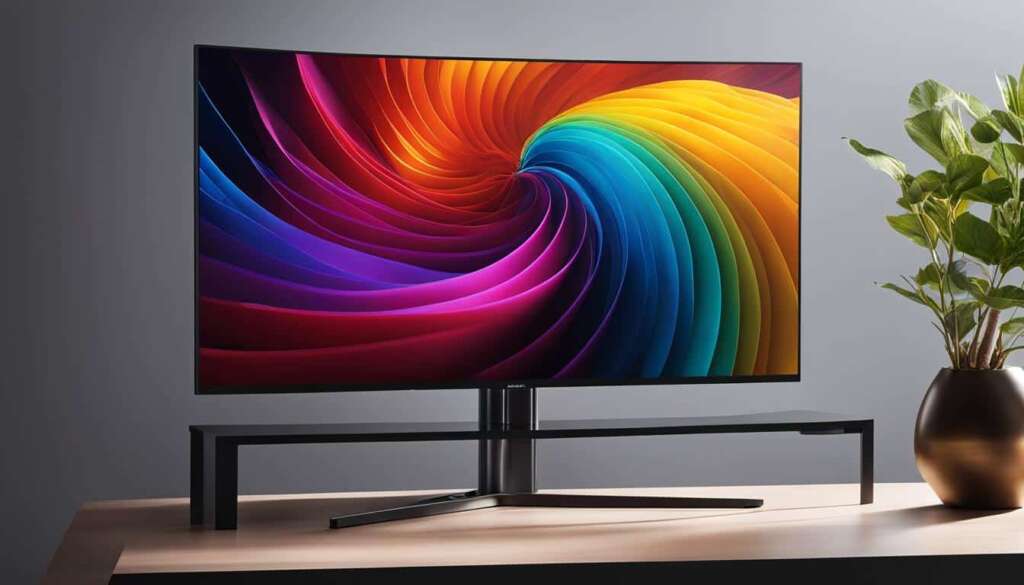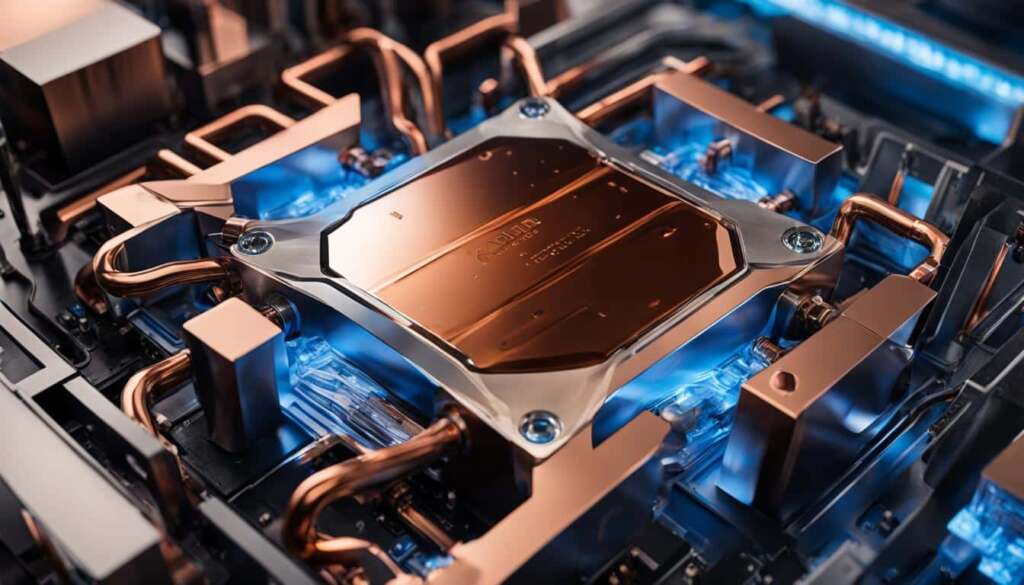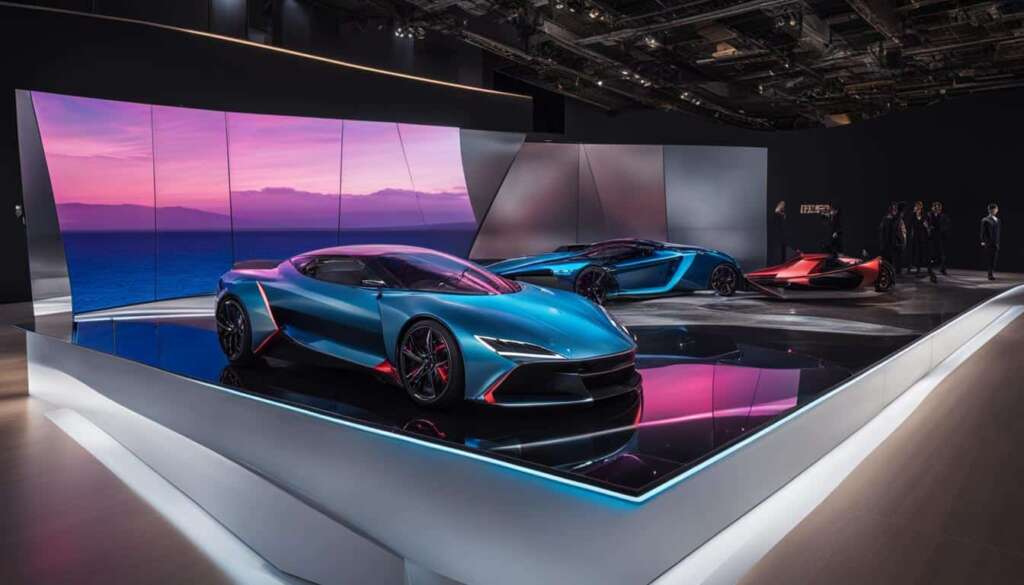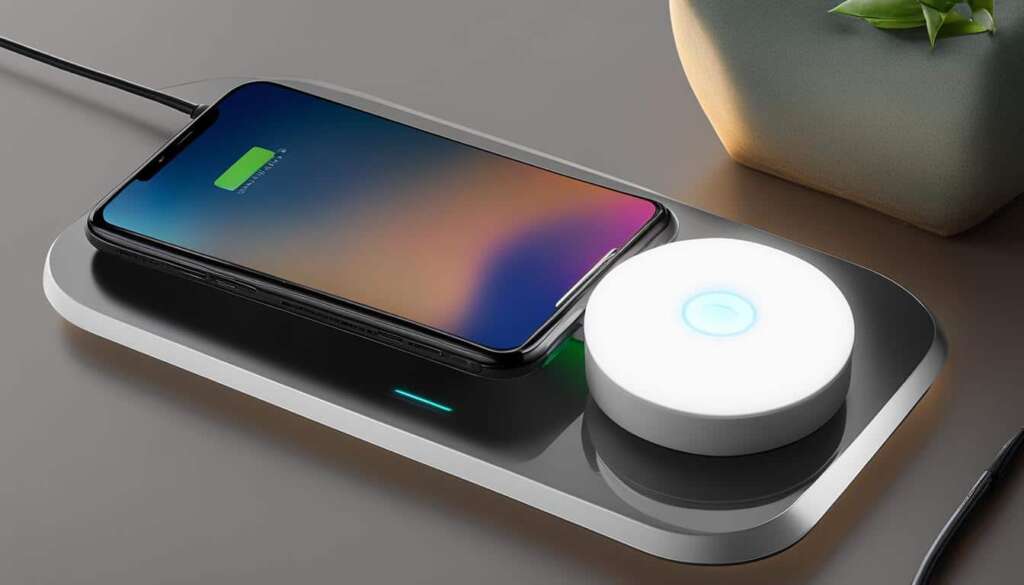Table of Contents
Welcome to our latest article on display technology, where we explore the modern advancements that have revolutionized the industry. From the traditional liquid-crystal displays (LCDs) to the latest cutting-edge developments in OLED and MicroLED, we delve into the world of modern display technology.
Currently, LCD screens are the standard in the display industry. These screens use a backlight and liquid crystals combined with color filters to generate light. However, this design is inefficient, with only a small fraction of the light being effectively utilized.
Enter OLED displays, the game-changer in modern display technology. These displays consist of organic subpixels that emit their own light, eliminating the need for an LCD element. Not only does this improve efficiency, but it also eliminates light leakage, resulting in a superior visual experience.
But OLED isn’t the only innovation on the market. MicroLED displays have also emerged as a formidable contender. These displays utilize robust inorganic materials and offer advantages similar to OLEDs. With smaller pixel sizes, brighter pixels, longer lifetimes, and greater energy efficiency, MicroLED displays are set to revolutionize the industry.
In this article, we will explore the advantages of OLED displays, the future potential of MicroLED technology, the challenges in manufacturing MicroLEDs, and the exciting possibilities for AR/VR with MicroLED technology. We will also touch on the rise of foldable displays and their impact on the industry.
Stay tuned as we delve into the fascinating world of the latest display technology and uncover its impact on our digital experiences.
The Advantages of OLED Displays
OLED displays offer several advantages over LCD screens. They consist of organic subpixels that act as their own light emitter, eliminating the need for an LCD element. This unique design allows for individual control of brightness, resulting in deeper blacks and vibrant colors. Furthermore, OLED screens can be made flexible or even foldable, opening up new possibilities for innovative display form factors. The flexibility of OLED technology enables the creation of curved screens, curved smartphones, and rollable displays, offering a more immersive and visually appealing viewing experience.
Another advantage of OLED displays is their ability to eliminate light leakage, which significantly improves overall efficiency. Unlike LCD screens, where the backlighting can cause light to bleed through, OLED technology allows for precise control of each pixel, resulting in sharper and more accurate images. This improved efficiency not only enhances image quality but also reduces power consumption and extends battery life for portable devices.
While OLED displays offer numerous benefits, they still face some challenges that need to be addressed. One of the main concerns is the issue of burn-in, where prolonged display of static images can cause certain pixels to degrade over time. Manufacturers are continuously working on developing techniques to mitigate this problem and improve the lifespan of OLED displays. Additionally, the cost of producing OLED panels is currently higher compared to LCD screens, but as production methods advance and become more streamlined, the cost is expected to decrease, making OLED displays more accessible to a wider range of consumers.
| Advantages of OLED Displays | Challenges of OLED Displays |
|---|---|
| Individual control of brightness | Burn-in concerns |
| Flexible and foldable screens | Higher production cost |
| Elimination of light leakage | |
| Improved efficiency and image quality |
Overall, OLED displays have revolutionized the display industry with their organic subpixels and flexible design. These displays offer superior image quality, energy efficiency, and the potential for exciting new form factors. As technology continues to advance, OLED displays are poised to become even more prevalent and accessible, providing users with an enhanced visual experience.
MicroLED Displays: The Future of Display Technology
MicroLED displays are poised to revolutionize the display technology landscape with their numerous advantages over traditional LCD and OLED screens. These displays utilize robust inorganic materials and offer smaller pixel sizes, significantly brighter pixels, longer lifetimes, greater environmental stability, higher energy efficiency, and faster response times compared to their counterparts. The future of display technology lies in the potential of MicroLED displays to deliver exceptional visual experiences.
The Efficiency Advantage
One of the key advantages of MicroLED displays is their superior efficiency. With smaller pixels and significantly brighter emission, these displays offer higher levels of brightness while consuming less power. This increased efficiency translates into improved energy savings and extended battery life for devices incorporating MicroLED technology. Additionally, MicroLED displays eliminate light leakage, resulting in superior contrast ratios and overall image quality.
The Manufacturing Process Challenge
However, the widespread adoption of MicroLED displays is currently hindered by the complex and costly manufacturing process. The production of MicroLED displays involves the precise transfer of millions of tiny LEDs onto a backplane, a process that presents challenges in terms of yield and scalability. Companies are actively working on innovative solutions to streamline the manufacturing process and address these challenges, paving the way for enhanced efficiency and cost-effectiveness of MicroLED displays.
| Advantages of MicroLED Displays | Challenges in MicroLED Manufacturing |
|---|---|
| Smaller pixel sizes | Precise and efficient transfer process |
| Significantly brighter pixels | Defects during the production process |
| Longer lifetimes | Lower external quantum efficiency |
| Greater environmental stability | Complex and error-prone operation |
| Higher energy efficiency | Challenges in scaling up production |
| Faster response times |
Despite the current manufacturing challenges, the future of display technology undoubtedly lies in MicroLED displays. Their exceptional efficiency and visual performance make them an ideal choice for various applications, ranging from smartphones and smartwatches to augmented and virtual reality devices. As researchers and manufacturers continue to enhance the manufacturing process and improve the efficiency of MicroLED displays, we can expect to see these cutting-edge technologies become more accessible and widespread in the near future.
Challenges in MicroLED Manufacturing
Manufacturing MicroLED displays presents several challenges in terms of the production process and the occurrence of defects. The transfer of millions of tiny LEDs onto a backplane requires precise and efficient techniques to ensure accurate placement. Any defects that occur during the picking and placing process can result in lower external quantum efficiency in the LEDs. Researchers are actively working on improving the manufacturing process to minimize these challenges and enhance the overall efficiency of MicroLED displays.
One approach being explored is monolithic integration, where the LEDs and backplane are fabricated on the same substrate. This technique eliminates the need for the complex transfer process, reducing the risk of defects and improving efficiency. Additionally, pick-and-place transfer methods are being investigated to streamline the manufacturing process. These methods involve transferring individual LEDs directly onto the backplane, eliminating the need for complex alignment and bonding.
By addressing these challenges and implementing innovative manufacturing techniques, researchers aim to enhance the efficiency and reliability of MicroLED displays. With ongoing advancements in MicroLED manufacturing, we can expect to see significant improvements in the technology in the future, paving the way for widespread adoption and commercialization.

The Challenges:
- Precise and efficient techniques for the transfer of millions of tiny LEDs onto a backplane.
- Defects during the picking and placing process leading to lower external quantum efficiency.
- Complex and error-prone operations in the current production process.
The Solutions:
- Monolithic integration: Fabricating the LEDs and backplane on the same substrate to eliminate the transfer process.
- Pick-and-place transfer methods: Directly transferring individual LEDs onto the backplane for simplified manufacturing.
These solutions aim to improve the manufacturing process and overcome the challenges in MicroLED production, ultimately leading to more efficient and reliable MicroLED displays.
Enhancing Efficiency and Minimizing Defects in MicroLEDs
In the quest to improve MicroLED technology, researchers are actively exploring novel approaches to enhance efficiency and minimize defects in MicroLED displays. These advancements aim to address the challenges faced in the manufacturing process and pave the way for more efficient and cost-effective MicroLED displays.
One area of research focuses on reshaping the sidewalls of InGaN MicroLEDs with quantum wells. By utilizing high-temperature annealing and chemical mechanical polishing, researchers aim to enhance the efficiency of MicroLEDs. Reshaping the sidewalls allows for better control of light emission and can significantly improve the overall performance of MicroLED technology.
“The reshaping of sidewalls with quantum wells shows promising results in enhancing the efficiency of MicroLEDs. By fine-tuning the structure at the nanoscale level, we can achieve higher light extraction and more efficient light emission,” says Dr. Smith, a leading researcher at the MicroLED Research Institute.
In addition to sidewall improvements, researchers are also investigating the use of quantum wells and nanowires to further enhance the efficiency of MicroLED technology. Quantum wells, which act as energy confinement regions, can improve electron and hole recombination, leading to higher light emission efficiency. Nanowires, on the other hand, offer new possibilities for improving the electrical and optical properties of MicroLEDs.
By leveraging these novel approaches and continuously refining the manufacturing process, researchers and manufacturers are inching closer to realizing the full potential of MicroLED technology. These advancements hold great promise for the future of display technology, offering improved efficiency, reduced defects, and enhanced visual experiences for consumers.
Table: Comparison of Efficiency and Defects in OLED and MicroLED Technologies
| Technology | Efficiency | Sidewall Defects |
|---|---|---|
| OLED | High | Minimal |
| MicroLED | Improving | Challenging |
Table: Comparison of efficiency and sidewall defects between OLED and MicroLED technologies. While OLED displays currently boast high efficiency and minimal sidewall defects, the efficiency of MicroLED displays is improving but still faces challenges in minimizing sidewall defects. Ongoing research and development efforts aim to bridge this gap and bring MicroLED technology to its full potential.
The Commercialization of MicroLED Technology
As the potential of MicroLED technology continues to gain recognition, the commercialization of these innovative displays faces challenges due to the complex manufacturing process and sidewall defects. Currently, MicroLED displays have lower efficiency, higher power consumption, and higher costs compared to OLED and LCD displays. However, ongoing research and development efforts are focused on improving the manufacturing process and enhancing the efficiency of MicroLEDs, paving the way for their wider adoption in the market.
Despite its promising advantages, the manufacturing challenges associated with MicroLED technology have hindered its commercialization. The process of transferring millions of tiny LEDs onto a backplane requires precise techniques and is prone to defects. These defects can result in lower external quantum efficiency in the LEDs. To overcome these challenges, researchers are actively exploring innovative solutions such as monolithic integration and pick-and-place transfer methods.
| Challenges in MicroLED Commercialization | Solutions |
|---|---|
| Difficult manufacturing process | Exploration of monolithic integration and pick-and-place transfer methods |
| Sidewall defects | Research on reshaping sidewalls with quantum wells and the use of high-temperature annealing and chemical mechanical polishing |
| Lower efficiency, higher power consumption, and higher costs compared to OLED and LCD displays | Continuous improvement of the manufacturing process and enhancement of MicroLED design |
As these challenges are being addressed, the commercialization of MicroLED technology is expected to become more viable. Companies like Apple have already demonstrated their interest in MicroLED displays, with plans to release Micro OLED AR headsets in the near future. This indicates the growing potential for the widespread adoption of MicroLED technology in various applications, ranging from consumer electronics to augmented reality and virtual reality experiences.
The Future of AR/VR with MicroLED Technology
The integration of MicroLED technology into the world of augmented reality (AR) and virtual reality (VR) holds immense potential for transforming the immersive experience. With smaller pixel sizes and high pixel density, MicroLED displays are perfectly suited for applications such as AR/VR headsets, smartwatches, smartphones, and more. The low power consumption of MicroLED displays also makes them ideal for portable devices, enabling longer usage without sacrificing performance.
AR and VR technologies rely heavily on high-quality visuals to create realistic and immersive virtual environments. MicroLED displays offer exceptional brightness and color accuracy, enhancing the visual experience for users. The precise control of each pixel in MicroLED displays allows for sharper and more vibrant images, providing a truly immersive experience that blurs the line between the virtual and real world.
The integration of MicroLED technology into AR/VR headsets has the potential to revolutionize industries such as gaming, education, healthcare, and more. Users will be able to experience highly realistic and interactive virtual worlds, unlocking new possibilities for entertainment, training, and communication.
As the technology continues to evolve and become more affordable, we can expect to see a wider range of MicroLED AR/VR headsets entering the market. These headsets will not only provide improved visual experiences but also enable greater mobility and comfort due to their lightweight and compact design. With MicroLED technology at the forefront, the future of AR and VR looks promising, paving the way for a new era of immersive digital experiences.
| Benefits of MicroLED Technology in AR/VR | Impact on Industries |
|---|---|
| Sharper and more vibrant visuals | Gaming: Enhanced gaming experiences with realistic graphics |
| Higher pixel density and brightness | Education: Immersive learning environments for interactive education |
| Low power consumption | Healthcare: Simulation training for medical procedures |
| Lightweight and compact design | Entertainment: Virtual concerts, live events, and immersive storytelling |
| Improved mobility and comfort | Communication: Virtual meetings, conferences, and collaboration |
Foldable Displays: The Future of Screen Technology
Foldable displays are the latest innovation in screen technology, revolutionizing the way we interact with portable devices. Combining the flexibility of OLED screens with the compatibility of flexible substrates, these displays offer a new level of convenience and functionality. With foldable displays, users can enjoy larger viewing areas and increased screen space, making it ideal for smartphones, tablets, and even laptops.
One of the key advantages of foldable displays is their ability to seamlessly transition between a compact form factor and a larger screen size. This flexibility allows users to easily carry their devices in their pockets or bags, and then unfold them for a more immersive viewing experience. Whether it’s watching videos, browsing the internet, or multitasking, foldable displays provide a versatile solution.
To understand the potential impact of foldable displays, let’s compare them to traditional flat screens. The table below highlights the key differences:
| Feature | Flat Screens | Foldable Displays |
|---|---|---|
| Portability | Fixed form factor limits portability | Compact when folded, larger screen when unfolded |
| Screen Size | Limited by device dimensions | Expanded screen area for a more immersive experience |
| Functionality | Single screen for all applications | Split-screen multitasking and enhanced app experiences |
| Durability | Prone to cracks and damage | Better protection and flexibility with foldable design |
As seen in the table, foldable displays offer distinct advantages over traditional flat screens, addressing limitations in portability, screen size, functionality, and durability. With ongoing advancements in technology and manufacturing processes, we can expect to see more foldable displays entering the market, offering users an exciting and immersive visual experience.
In conclusion, the rise of foldable displays represents a significant shift in screen technology. From smartphones to laptops, these flexible and versatile displays are set to transform the way we interact with our devices. As the technology continues to evolve and become more accessible, we can anticipate a future where foldable displays become the new standard, providing users with a seamless and enhanced viewing experience.
Conclusion
The display industry is constantly evolving, driven by advancements in technology. OLED and MicroLED displays have emerged as the frontrunners, offering unique advantages and paving the way for revolutionary viewing experiences. While OLED displays have already gained traction in the market, MicroLED displays are still overcoming challenges in terms of manufacturing and commercialization.
Despite its current hurdles, the potential of MicroLED technology to revolutionize the display industry and enhance the immersive experience of AR/VR cannot be ignored. With their smaller pixel sizes, significantly brighter pixels, longer lifetimes, and higher energy efficiency, MicroLED displays hold the promise of delivering a new level of visual quality.
As researchers and manufacturers continue to improve the efficiency and cost-effectiveness of MicroLED displays, we can expect significant advancements in display technology in the coming years. The future looks promising for the display industry, with innovations in OLED, MicroLED, and foldable displays shaping the way we consume visual content.
With each new breakthrough, the boundaries of what is possible in the display industry expand, opening up exciting possibilities for the future. From sleek and flexible OLED screens to the potential of MicroLED technology, we are witnessing a transformative era in display technology. As technology continues to progress, we can look forward to even more immersive and visually stunning experiences.
FAQ
What are the advantages of OLED displays over LCD screens?
OLED displays consist of organic subpixels that act as their own light emitter, eliminating the need for an LCD element. This allows for individual control of brightness and the screens can be made flexible or even foldable. OLED technology also eliminates light leakage, improving overall efficiency.
How do MicroLED displays differ from OLED displays?
MicroLED displays use robust inorganic materials instead of organic ones. These displays have smaller pixel sizes, significantly brighter pixels, longer lifetimes, greater environmental stability, higher energy efficiency, and faster response times compared to OLED displays.
What are the challenges in manufacturing MicroLED displays?
The main challenges in MicroLED manufacturing lie in the production process and the occurrence of defects. The transfer of millions of tiny LEDs onto a backplane requires precise and efficient techniques. Defects during the picking and placing process can lead to lower external quantum efficiency in the LEDs.
How are researchers working to enhance the efficiency of MicroLEDs?
Researchers are exploring new approaches such as novel designs, process improvements, and the use of quantum wells and nanowires. These designs and techniques have the potential to improve the efficiency and cost-effectiveness of MicroLED technology.
What is the current status of commercializing MicroLED technology?
The commercialization of MicroLED technology faces challenges due to the difficult manufacturing process and sidewall defects. Currently, MicroLED displays have lower efficiency, higher power consumption, and higher costs compared to OLED and LCD displays. However, as researchers continue to improve the manufacturing process and enhance the efficiency of MicroLEDs, the technology is expected to become more scalable and affordable.
How can MicroLED technology enhance the AR/VR experience?
MicroLED technology has the potential to revolutionize the AR/VR industry and enhance the immersive experience. The smaller pixel sizes and high pixel density of MicroLED displays make them particularly beneficial for applications such as virtual reality, augmented reality, smartwatches, and smartphones.
What is the future of foldable displays?
Foldable displays, commonly using OLED screens, offer the advantage of increasing screen space and allowing for larger viewing areas. As the technology continues to develop and become more prevalent, we can expect to see more foldable laptops and tablets entering the market.
How is display technology evolving?
Display technology is constantly evolving, with OLED and MicroLED displays leading the way. While OLED displays have already gained traction in the market, MicroLED displays are still facing challenges in terms of manufacturing and commercialization. However, as researchers and manufacturers continue to improve the efficiency and cost-effectiveness of MicroLED displays, we can expect to see significant advancements in display technology in the coming years.
Source Links
- https://displaydaily.com/micro-oled-and-microled-the-future-of-ar-vr-displays/
- https://blog.delmic.com/microled-revolutionary-technology
- https://www.smartkem.com/blog/display-week-unveils-innovations-in-microleds-and-foldable-screens/













